Around the World Otto Kotzebue
The beginning of the XIX century opens a glorious era in stories domestic shipping. In 1803-1806, the first round-the-world expedition under the Russian flag, headed by I. F. Krusenstern, took place. It was followed by new expeditions. They were led by V. M. Golovnin, F. F. Bellingshausen, M. P. Lazarev, and others. Otto Yevstafyevich (Avgustovich) Kotzebu held an honorable place in this brilliant pleiad of world cruisers. This famous Russian sailor and scientist was born 19 December 1788, in Revel.
The father of the future navigator, Augustus Kotzebue, was a famous playwright writer. In 1796, Otto entered the Cadet Corps in St. Petersburg. He was not going to be a sailor. However, early widowed Augustus Kotzebue married the sister of I. Kruzenshtern, and this determined the fate of his son. In 1803, Mr. Kruzenshtern took Otto onto the sloop "Hope".
At the end of the round-the-world voyage, Otto Avgustovich Kotzebue was promoted to midshipman, and in 1811 he became a lieutenant. At this time, Kruzenshtern was developing a project of a world-round expedition task, which he puts the opening of the Northwest Passage - the sea route around the northern shores of America. A search for a passage from the Pacific would also help answer the question: Is Asia connected to America? In 1648, Mr. S. Dezhnev, following from the mouth of the Kolyma River to the Gulf of Anadyr around the Chukotka Peninsula, proved that Asia and America are separated by a strait. However, this strait was not put on the map. Krusenstern was also going to clarify the position of the many islands of the Pacific Ocean and, if possible, discover new islands.
Fascinated by the plans of Kruzenshtern, Count N. Rumyantsev, who held the post of chancellor, offered his money to build for the expedition a small (180 t) brig. Kotzebue was appointed commander of the still-under construction in Abo “Rurik” on the recommendation of Krusenstern. The brig armed 8 with cannons and raised a naval flag on it.
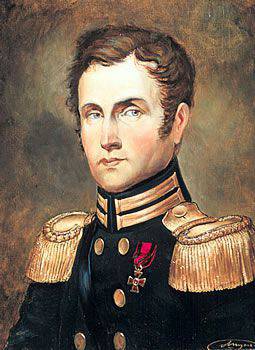
In addition to Lieutenant Kotzebue, lieutenants G. Shishmarev and I. Zakharyin, doctor I. Eshsholts, artist L. Horis, navigator students, sailors and noncommissioned officers set off to circumnavigate the globe. Later in Copenhagen, naturalists M. Vormskyold and A. Chamisso boarded the ship.
Early in the morning of July 30, 1815, the brig Rurik raised sails and left Kronstadt. After a brief stop in Copenhagen, 7 September arrived in Plymouth. After checking the chronometers, Kotzebue hurried to go out into the ocean, but storms forced him back twice. Only October 6 Brig managed to get out of the English Channel. On the island of Tenerife, Russian sailors replenished stocks. Then the brig crossed the Atlantic Ocean without any special adventures and September 12 anchored off the island of Santa Catarina (Brazil).
After preparing for the difficult voyage around Cape Horn, 28 December travelers traveled further south and a few days later fell into a strip of storms. 10 January 1816, a big wave hit the brig's stern, breaking the railings on the shuttleways, the hatches that closed cannon ports, threw the gun from one side to the other, broke the deck over Kotzebue's cabin, and dropped the lieutenant off of the schans and would inevitably wash over the board if he would not grab the rope.
Finally Cape Horn was left behind, and the brig went north along the coast of Chile. 12 February 1816 The Chileans were surprised to see the first Russian ship to appear in Concepcion Bay.
March 8 "Rurik" left the bay and after 20 days, approached Easter Island. Residents greeted the sailors with hostility. As it turned out later, the islanders' distrustfulness was explained by the actions of a single American captain, who in 1805 seized and took about 20 residents of the island on his ship.
From Easter Island, the brig headed northwest, and on April 20, in the Tuamotu archipelago, Russian sailors saw a coral island, not yet marked on the maps. This first island, discovered by the expedition, was named by Kotzebue in the name of the swimming organizer, Count N. Rumyantsev (now Tiksi). 23 and 25 of April were opened two more groups, which received the names of the islands of Rurik (now Arutua and Tikehau). Moving west, the 21 — 22 travelers in May 1816 discovered two more groups and named them the islands of Kutuzov and Suvorov. They were in the eastern chain of the Marshall Islands. On this research in the South Pacific had to stop, it was necessary to rush to the north, in the Bering Strait.
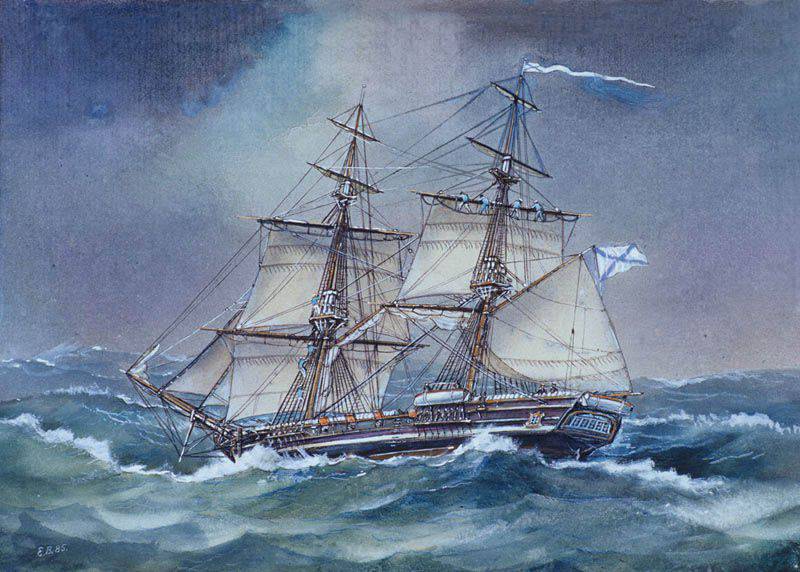
19 June "Rurik" entered Avacha lip. Began preparing for polar swimming. Lieutenant Zakharyin fell ill, and had to go north with only one officer - Lieutenant Shishmaryov. The natural scientist Wormskyold, who decided to study the nature of Kamchatka, remained in Petropavlovsk.
15 July 1816 of the Year “Rurik” left Petropavlovsk. On July 30 the brig crossed the Bering Strait between the cape of the Prince of Wales and the islands of Diomede. Kotzebue decided that he had discovered the fourth island in this group and gave him the name of one of the participants of the first Russian round-the-world trip M. Ratmanov. Although this time the discovery turned out to be imaginary, the name stuck on the largest western island.
From the Cape, the Prince of Wales brig headed along the coast, hoping to find a passage to the Atlantic. 13 July Russian sailors discovered the bay and a small island. They were called the Bay of Shishmareva, in honor of one of the officers “Rurik”, and the island of Sarychev, after the name of the famous Russian navigator and hydrograph.
After Shishmareva Bay, the coast began to turn to the east, and then abruptly turned south. It seemed the long-awaited strait was found. On August 2, Russian sailors had no doubt that they were in a wide passage that led to an unknown sea. Continuing east and southeast, travelers landed on the coast of Alaska and the island several times, and they found fossil ice, in which mammoth bones and tusks came across.
However, I had to say goodbye to the hopes of opening the passage in a few days. 7 and 8 August, the sailors explored the extreme eastern part of the imaginary strait and found that the shore is closed. "Rurik" was not in the strait, but in a huge bay. Its eastern part, from which mariners had to turn back, Kotzebue called Escholz's lip, and the island located at the entrance to the lip, Chamisso Island. The whole bay stretching to 300 km, the exploration of which by the Russian sailors from 1 to 14 in August, all the members of the expedition decided to name Kotzebue. The cape on the northern shore of the bay at the entrance to it was named Krusenstern.
On the way back, the navigator explored the western, Asian, shore of the Bering Strait and one of the first to conclude that "Asia in the past was one with America: Diomede Islands are remnants of a previously existing connection."
In the Bering Strait, Kotzebue found a fairly strong current. Measurements have shown that it has a speed of up to 3 miles per hour at the deepest point of the fairway and has a northeast direction. Otto Avgustovich considered the current evidence of the existence of a passage around the northern shores of America.
November 21 "Rurik" arrived to the Hawaiian Islands. He first stopped at the island of Hawaii, where Kotzebue met with King Kamehamea, and then went to Honolulu. Kotzebue familiarized himself with the customs of the Hawaiians and made the first survey of the Honolulu harbor.
14 December 1816, the brig went to the Kutuzov and Suvorov islands opened in May in order to continue their research in the Marshall Islands. 4 January ship approached a new group of unknown coral islands. For a more detailed study of them, Kotzebue led the brig into the lagoon. "Rurik" slowly moved along the lagoon from one island to another, and finally stopped at the largest one, which was called Odia.
February 7 "Rurik" moved south. Within three weeks new groups of islands were opened, which received, in honor of the former minister of the sea, the name of the islands of Chichagov. February 10 - Arakcheev Islands, and February 23 - islands, which were named after the Marquis de Traverse. From these islands, Rurik headed north to return to the Bering Strait by summer. On the night of April 12, 1817, the travelers fell into a storm. At 4 one o'clock in the night a huge wave struck the brig, breaking the bowsprit and the steering wheel. One of the sailors hurt his leg; the non-commissioned officer nearly washed off into the sea. Kotzebue wave itself struck his chest on a sharp corner, and he lost consciousness.
24 April "Rurik" entered the harbor Unalashki. The sailors repaired the damage, almost completely replaced the mast and rigging, reinforced the lagged copper lining and 29 June entered the Bering Strait. Approaching the island of St. Lawrence, the crew of the ship saw that the entire Bering Strait was still covered with ice. It became clear that even if the strait, after some time cleared, it would not be able to penetrate far to the north this year. And Otto Avgustovich himself has not recovered from a strike during a storm. Kotzebue hesitated for a long time. He wanted, "despising the danger of death, to end his enterprise." However, as the commander of the ship, he was obliged to think about the safety of the ship and crew. Therefore, the head of the expedition decided to stop trying to get into the Bering Strait.
July 22 "Rurik" returned to Unalaska and August 18 sailed back to the shores of Europe. Having repaired the brig in Manila, 29 navigators in January 1818 of the year headed south to the Sunda Strait into the Indian Ocean. Kotzebue was warned that there are many pirates in these places. Indeed, as soon as the Rurik crossed the equator, the Russian sailors noticed that they were being pursued by a Malay pirate ship. Kotzebue ordered to prepare for battle. The pirate ship overtook the brig, and at night blocked his way. But on the "Rurik" time noticed the enemy. The captain ordered to turn the starboard to the enemy and launch a volley from the cannons. The pirates, accustomed to dealing with merchant ships and not expecting such resistance, turned and quickly retreated. The brig safely passed the Sunda Strait, crossed the Indian Ocean and passed around the Cape of Good Hope. 3 August 1818 of the Year “Rurik” entered the Neva and anchored in front of the home of the organizer of the expedition, Chancellor N. Rumyantsev. The voyage around the world has been completed.
Despite the fact that the Northwest Passage could not be found, sailing on the Rurik became one of the most scientific expeditions of the 19th century. Kotzebue made many important geographical discoveries in the Bering Strait and in the South Pacific, clarified the position of the islands discovered by other seafarers.
The members of the expedition collected large ethnographic collections. Meteorological and oceanographic observations made during the voyage were of great importance.
Three years after the end of the expedition in St. Petersburg, the two-volume essay by Kotzebue “Journey to the Southern Ocean and the Bering Strait” was published, and a couple of years later a third volume was published, in which articles from other members of the expedition were collected, as well as records of scientific observations. Already in 1821, Kotzebue’s notes were translated and published in English, German, and Dutch.
Upon returning from a voyage on the Rurik, Lieutenant Commander Kotzebue served as an officer for special assignments under Admiral A. Spiridov, Commander-in-Chief of the Port of Revel, and from 1823 to 1826. made a new round-the-world transition to the Enterprise's 24-gun sloop. During this voyage, they discovered the Island of Enterprise (Fangahin) in the Tuamotu Archipelago, Bellingshausen Island (Mato Ona - 450 km from Tahiti) and the northern islands of the Ralik chain - Rimsky-Korsakov (Roghelap) and Eschholz (Bikini) atolls.
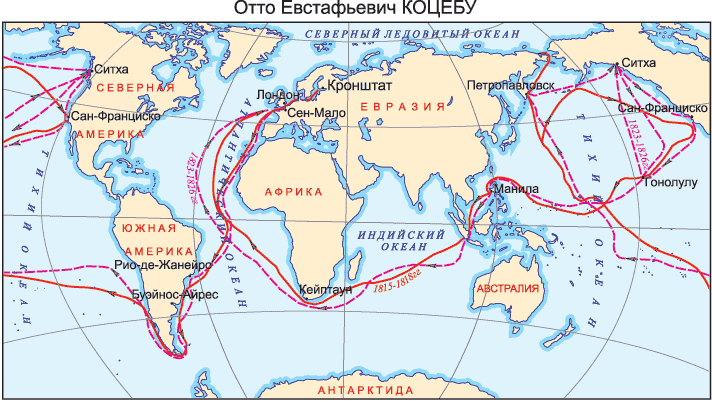
The oceanographic results of the expedition at the “Enterprise” were even more significant than the results of navigation on the “Rurik”. Particularly noteworthy are the works of the physicist E. Lenz who sailed on the sloop, who used a batometer designed by him together with Professor E. Parrot for taking water samples from various depths and a device for measuring depths.
At the end of the expedition, the captain of the 2nd rank Otto Augustovich Kotzebue was again seconded to the head of the Revel port, then he was appointed commander of the 23rd naval crew, in 1828 he was transferred to the Guards Navy crew. In 1830, “on frustrated health,” retired with the rank of captain I rank. The seafarer who left the fleet settled on his estate near Revel, where he died in 1846.
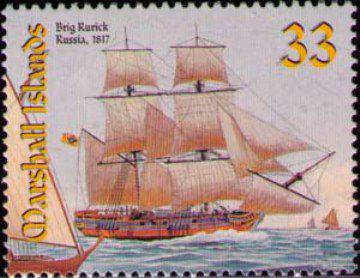
Sources:
Kotzebue O. Traveling around the world. M .: Drofa, 2011. C. 1-4.
Z. Vinogradova. O. E. Kotzebue's research in the Pacific Ocean while sailing the Rurik brig in 1815-1818. // Collection "Countries and peoples of the East." Release №24. M .: Science, 1982. C. 24-37.
Sheshin A. Navigation Otto Kotzebue // Marine Fleet. 1988. No.12. C.53-54.
Pasetsky V. Russian discoveries and research in the Arctic. The first half of the XIX century. L .: Gidrometeoizdat, 1984. C. 67-82.
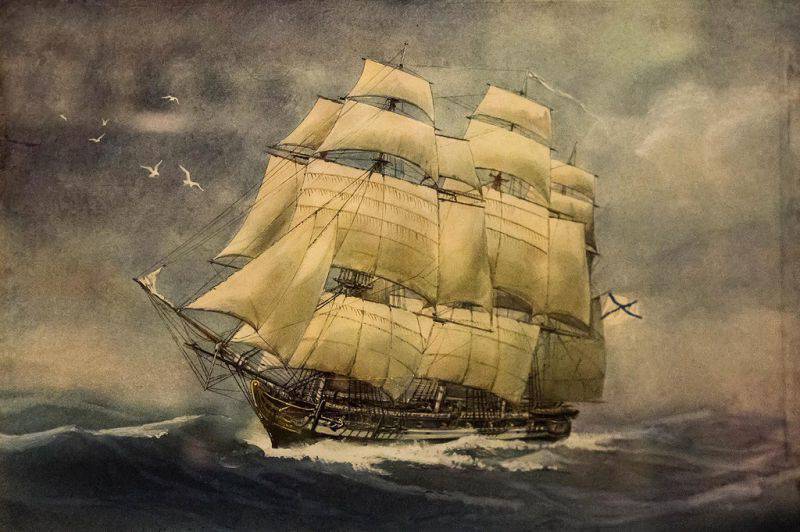
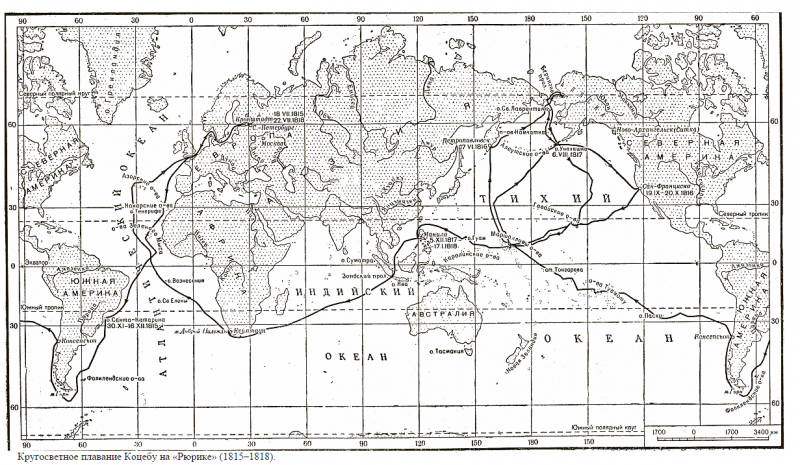
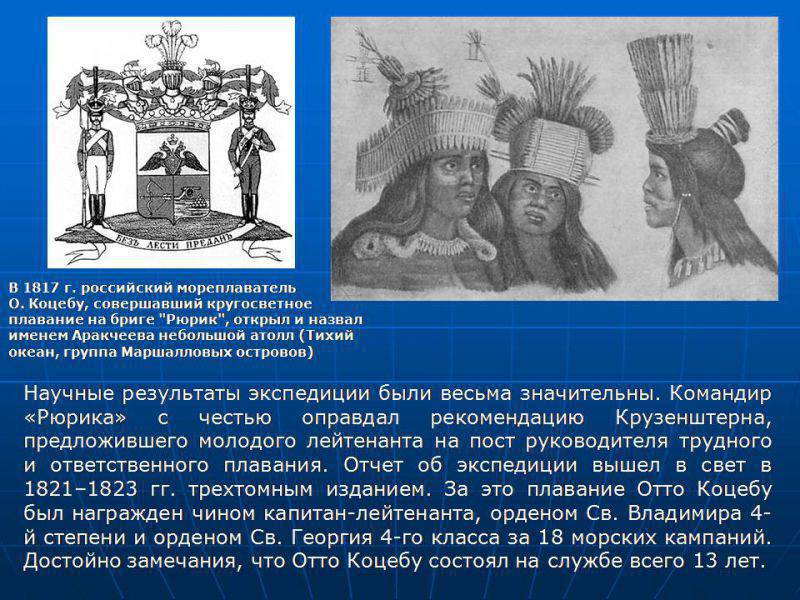
Information